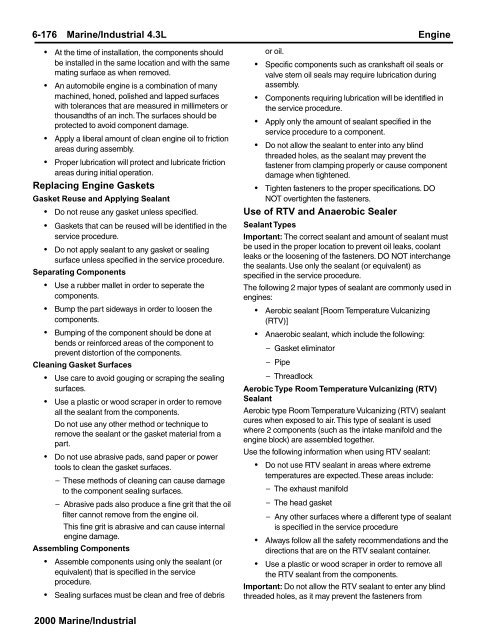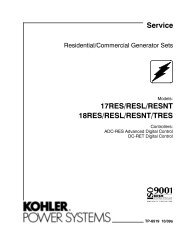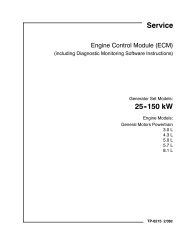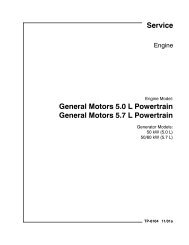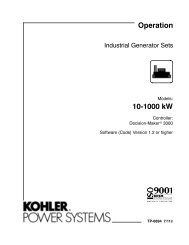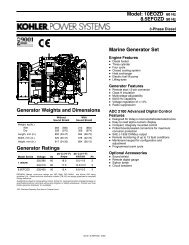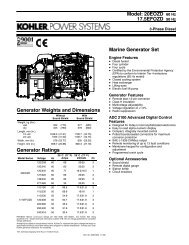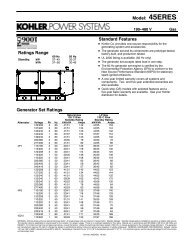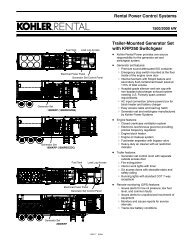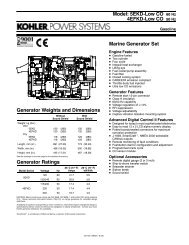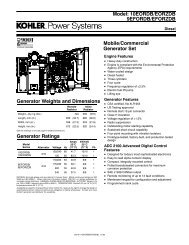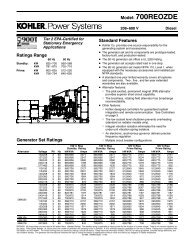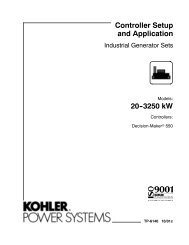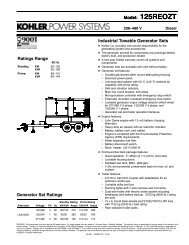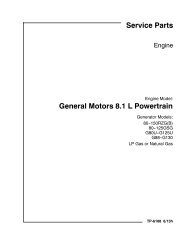Service Manual, General Motors 4.3L Engine (TP ... - Kohler Power
Service Manual, General Motors 4.3L Engine (TP ... - Kohler Power
Service Manual, General Motors 4.3L Engine (TP ... - Kohler Power
Create successful ePaper yourself
Turn your PDF publications into a flip-book with our unique Google optimized e-Paper software.
6-176 Marine/Industrial <strong>4.3L</strong> <strong>Engine</strong><br />
• At the time of installation, the components should<br />
be installed in the same location and with the same<br />
mating surface as when removed.<br />
• An automobile engine is a combination of many<br />
machined, honed, polished and lapped surfaces<br />
with tolerances that are measured in millimeters or<br />
thousandths of an inch. The surfaces should be<br />
protected to avoid component damage.<br />
• Apply a liberal amount of clean engine oil to friction<br />
areas during assembly.<br />
• Proper lubrication will protect and lubricate friction<br />
areas during initial operation.<br />
Replacing <strong>Engine</strong> Gaskets<br />
Gasket Reuse and Applying Sealant<br />
• Do not reuse any gasket unless specified.<br />
• Gaskets that can be reused will be identified in the<br />
service procedure.<br />
• Do not apply sealant to any gasket or sealing<br />
surface unless specified in the service procedure.<br />
Separating Components<br />
• Use a rubber mallet in order to seperate the<br />
components.<br />
• Bump the part sideways in order to loosen the<br />
components.<br />
• Bumping of the component should be done at<br />
bends or reinforced areas of the component to<br />
prevent distortion of the components.<br />
Cleaning Gasket Surfaces<br />
• Use care to avoid gouging or scraping the sealing<br />
surfaces.<br />
• Use a plastic or wood scraper in order to remove<br />
all the sealant from the components.<br />
Do not use any other method or technique to<br />
remove the sealant or the gasket material from a<br />
part.<br />
• Do not use abrasive pads, sand paper or power<br />
tools to clean the gasket surfaces.<br />
– These methods of cleaning can cause damage<br />
to the component sealing surfaces.<br />
– Abrasive pads also produce a fine grit that the oil<br />
filter cannot remove from the engine oil.<br />
This fine grit is abrasive and can cause internal<br />
engine damage.<br />
Assembling Components<br />
• Assemble components using only the sealant (or<br />
equivalent) that is specified in the service<br />
procedure.<br />
• Sealing surfaces must be clean and free of debris<br />
or oil.<br />
• Specific components such as crankshaft oil seals or<br />
valve stem oil seals may require lubrication during<br />
assembly.<br />
• Components requiring lubrication will be identified in<br />
the service procedure.<br />
• Apply only the amount of sealant specified in the<br />
service procedure to a component.<br />
• Do not allow the sealant to enter into any blind<br />
threaded holes, as the sealant may prevent the<br />
fastener from clamping properly or cause component<br />
damage when tightened.<br />
• Tighten fasteners to the proper specifications. DO<br />
NOT overtighten the fasteners.<br />
Use of RTV and Anaerobic Sealer<br />
Sealant Types<br />
Important: The correct sealant and amount of sealant must<br />
be used in the proper location to prevent oil leaks, coolant<br />
leaks or the loosening of the fasteners. DO NOT interchange<br />
the sealants. Use only the sealant (or equivalent) as<br />
specified in the service procedure.<br />
The following 2 major types of sealant are commonly used in<br />
engines:<br />
• Aerobic sealant [Room Temperature Vulcanizing<br />
(RTV)]<br />
• Anaerobic sealant, which include the following:<br />
– Gasket eliminator<br />
– Pipe<br />
– Threadlock<br />
Aerobic Type Room Temperature Vulcanizing (RTV)<br />
Sealant<br />
Aerobic type Room Temperature Vulcanizing (RTV) sealant<br />
cures when exposed to air. This type of sealant is used<br />
where 2 components (such as the intake manifold and the<br />
engine block) are assembled together.<br />
Use the following information when using RTV sealant:<br />
• Do not use RTV sealant in areas where extreme<br />
temperatures are expected. These areas include:<br />
– The exhaust manifold<br />
– The head gasket<br />
– Any other surfaces where a different type of sealant<br />
is specified in the service procedure<br />
• Always follow all the safety recommendations and the<br />
directions that are on the RTV sealant container.<br />
• Use a plastic or wood scraper in order to remove all<br />
the RTV sealant from the components.<br />
Important: Do not allow the RTV sealant to enter any blind<br />
threaded holes, as it may prevent the fasteners from<br />
2000 Marine/Industrial


